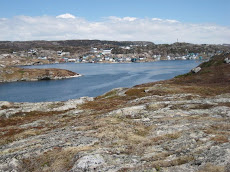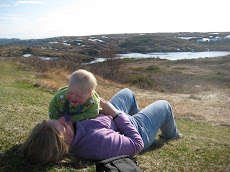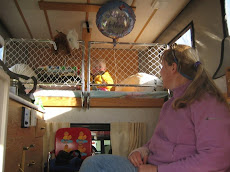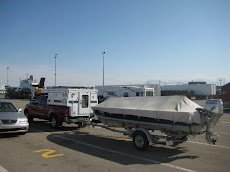It feels as though we are finally in true sabbatical mode. In the past weeks we have visited the Russells in Bonavista (parents of our friend Caroline Todd, wife of College of the Atlantic’s marine mammologist, Sean Todd); seen the Atlantic Puffin colony and the Puffin Festival in Elliston; traveled around the island communities of Fogo, Tilting, and Change Island (which is on the Change Islands); went to the Fish, Fun, and Folk Festival in Twillingate; visited the old whaling port of Dildo, and, of course, made our regular trip back to St. John’s for medical follow-up (for Anouk and me). We have seen several Moose, although nothing to rival the 83 we saw in two weeks last year when we visited the province. I have gone fishing (remember, in Newfoundland, there is only fish known as ‘fish’ and that is the Atlantic Cod). And I have seen some birds.
Let me rephrase that: I have seen a LOT of birds! Maybe it is just that we are finally venturing further away from St. John’s and the landscape is changing, although everywhere the eye looks it seems to still take in vast forests of Black Spruce on the uplands with peat bogs in the depressions. Maybe it is just that summer has finally hit (June was so called that a Newfoundlander we had dinner (the mid-day meal) with at Masonic Lodge at the Fish, Fun, and Folk Festival referred to it as Junuary) with temperatures consistently in the high 20s (that would be Celsius) province-wide for weeks now. And maybe it was that I have been haunted with that threshold lure of 100 birds that has been eluding me for so long. Whatever the reason, I have suddenly been seeing more birds.
Greater Yellowlegs were seemingly on every exposed bit of intertidal mudflat in Notre Dame Bay; the occasional Lesser Yellowlegs (I don’t know about you, but I wouldn’t want to be known as the ‘lesser’ of anything—perhaps they should be named Bigger and Smaller Yellowlegs, or Yellowlegs-With-The-Slightly-Recurved-Bill and just plain Yellowlegs, or Yellowlegs-With-The-slightly-Knobbier-Knee-Joint and Yellowlegs, or we could save a lot of angst, have everyone learn Latin, and simply refer to them by their scientific names of Tringa melanoleuca and Tringa flavipes) side-by-each with the Greater clearly illustrates the size difference. That elusive song I have been hearing for the whole of our travels, that song that is tonally akin to the American Robin, but is not the American Robin…well, I finally managed to find the mystery songster perched cooperatively atop a spruce: a Fox Sparrow. And now they seem to be singing EVERYWHERE! Fledgling Dark-eyed Juncos are falling out of their nest. Literally. Walk in the woods and they are regularly underfoot.
A Common Yellowthroat (15 July) and Roseate Tern (16 July) in Elliston. Yellow-bellied and Alder Flycatchers (18 July) in Chance Cove. Least Sandpiper (20 July), Caspian Tern and Fox Sparrow (21 July), Ruddy Turnstone (22 July), and a Parasitic Jaeger (23 July) while out fishing, all Fogo Island and vicinity. Mourning Dove (27 July) in Twillingate.
The avian highlight of the trip so far, though, is also a life-bird for me (which is particularly exciting because I don’t see life-birds very often anymore).
While we were camping at the municipal park in the village of Fogo, on Fogo Island, I went for an early morning perambulation to the privy to, well, you know. The approach is a boardwalk with a series of single-step level changes. My eyes blurred with sleep (it was about 4:00 in the morning, after all), I stepped forward, except there was no boardwalk, or, rather, it was one course lower. I went keester over kettle, seriously spraining my left foot. @#$%! It hurt, and I eventually struggled back to my feet. By the time I got back to the COW (Cabin-On-Wheels) the inside ball of my foot was swollen and black-and-blue with a nice (or not so nice, depending on your literary interpretation) knot on the top of my foot. It hurt enough to warrant a visit to the hospital. Fortunately for me, x-rays did not reveal anything broken.
So how, you may be asking, does this fit in with a life-bird? Bear with me…. As you may know, one of my many favorite expressions is why use a hundred words when a thousand will do?
The next day we went to the National Historic Register village of Tilting where we met Bonnie, an anthropologist from Rutgers who has been regularly coming to Tilting since her graduate research days thirty-some years ago. Bonnie offered to take us on a hike along the Turpin Trail. Given my bum foot (remember my stumble in Fogo?), which compliments my pinched-sciatic-nerve-numbed right, I chose to stay behind to watch birds. I set out my spotting scope and started scanning the nearby beach and mudflats. Greater Yellowlegs. Greater Yellowlegs. Greater Yellowlegs. Greater Yellowlegs. Lesser Yellowlegs. Spotted Sandpiper. Spotted Sandpiper. American Robin. Fox Sparrow. Dark-eyed Junco. Ruddy Turnstone! I love Ruddy Turnstones! They are a beautiful boreal shorebird that I only occasionally see in migration…and clearly this one is at the very early end of fall migration. I spent a lot of time looking at the Turnstone, scanning some of the surrounding area, but always coming back to the Turnstone.
As I was watching the Turnstone for the umpteenth time, a bird walked in front of it that looked different. Smaller than the Turnstone. Smaller than the nearby American Robin. A bit of reddish in the flanks. Sort of a wedge-shaped lighter border on the side of the head. Clearly a passerine, but what is it? A Horned Lark? No. An American Pipit? Definitely not. B’y, based on my memory of the two Varied Thrushes I have seen in my life, could it be that? Dare I run, er, I mean, hobble back to COW to get my field guide? No choice, I don’t know for sure what this bird is. Look a few more minutes, take a few more field notes to aid identification just in case it is not there when I return. An interminable age later I return with my 5th edition of the National Geographic Guide to the Birds of North America. Varied Thrush. Page 350. NO! IT IS NOT A VARIED THRUSH! But it is so thrush-like!
EUREKA! The red flanks and the wedge-shaped markings on the side of the head are definitive! I am looking at a Redwing! (No wonder it was so thrush-like, it is of the genus Turdus, the same as the American Robin, which is also in the thrush family.) This is a Eurasian bird that, according to my field guide, is known to show up in Newfoundland! I watched the bird for a long time, taking numerous digi-scope pictures (that is where you hold up your camera to the lens of the spotting scope and press the shutter release) and movies.
Uh-oh, I may have watched the Redwing for too long. I hopped (hobbled) in the COW and took off down the road to meet Natalie, Anouk, and Bonnie, who were walking down the road toward me. Oops…
Total Newfoundland birds: 106
Monday, July 28, 2008
Subscribe to:
Post Comments (Atom)



































4 comments:
Hey Rich,
I've been trying to email you but everything is being kicked back. Are you ready to send in your next segment for the Downeast Audubon newsletter? Deadline is supposed to by Aug. 15 but can get pushed a week later, I suppose! Please include jpeg photos and a way to email you besides this! Thanks,Leslie
Glad to read the bird count is up, the doctor time is down, and the research and sight-seeing are just awesome. truly having fun living vicariously! Keep up the writing for the rest of us :)
A ruddy turnstone, 'eh? I've seen some of those down here in Sarasota. They sometimes pass through our beaches on their migration. At least, that's what the Audubon people tell me.
Rich and Natalie
We had a great time with you guys in Newfoundland. Unfortunately the vacation was too short. We made it back OK. Did have a little problem with the truck blowing a hose off the turbo charger, but no damage and I was able to put back on and we were on our way 1/2 hour later.
Our moose count did not change from 29 after we left you. The ferry ride was great, blue sky the whole way. We were able to see the coastline of Cape Breton.
We did make it down to Rose Blanche. I'm glad we did not go there with the trailer, just driving around with the truck was tight enough. I wonder if they can make smaller and steeper streets?
At the ferry they took our patatoes and had I had any dirt on the trailer or truck they were ready to wash it. Something about a potatoe blite. They did ask if we had any burlap, they were confiscating that also.
Hoping to see another blog soon.
Renny
Post a Comment